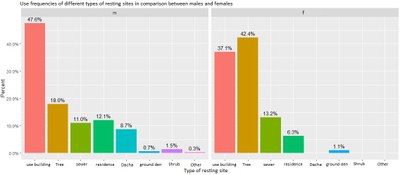Characterization of resting sites of raccoons in Berlin
Alexander Zillmann
Since the introduction of the raccoon (Procyon lotor) in Europe approximately 100 years ago, the species has spread widely over the continent and the population density is steadily growing. While the species spatial behaviour in natural habitats is well researched, knowledge about urban living raccoons is very sparse and there is no study about raccoons in berlin at all. Understanding the resting site behaviour is crucial, since urban living raccoons often use buildings as their daily resting sites, what can lead to conflicts with local residents.
In my study, I used GPS-data of 14 individuals to locate and characterize their resting sites in retrospect. GPS-data was collected with tracking collars between September 2016 and April 2018. Primarily, GPS-pings recorded during the daytime (racoons are nocturnal) were handled in QGis to find the positions of the resting sites. With a handheld GPS-device, the worked out locations of the resting sites were visited in the field and characterized, respectively divided into categories. Determining the resting sites in the field was difficult or not always possible, because sometimes there were no signs of raccoon inhabitation at some postitions. During the field work it became clear, that this is a method problem in general.
Using the collected data, resting site preferation, frequency of use of resting sites and differences between seasons and sex have been described and compared to two selected comparative studies (Hadidian et al. 1991,Michler 2003).

